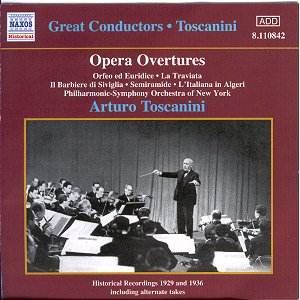The idea behind this CD is to present eleven of the
great conductor’s recordings often made on the same day and to demonstrate
the subtle differences behind performances of the same work. Some of
these performances were issued originally, some later, some never.
It is very much a CD for the Toscanini enthusiast,
the 'completist', as you will hear three versions of the ‘Dance of the
Blessed Spirits’ and Rossini’s ‘Barber of Seville Overture’, two of
Verdi’s La Traviata Prelude etc. Even so, it is a fascinating exercise
to pay particular attention to these interpretations and to admire the
sheer beauty of the results even after the dust of about 70 years.
Mark Obert-Thorn adds a very useful note on the recordings
and I will quote him. He writes ….."it was standard policy to make three
takes of a given side. One would be marked M [for master] and this became
the released version. The other takes might be marked H30 or H [for
hold 30 days or hold indefinitely, respectively] or D for destroy. Over
the years these recordings remained in the catalogue, the metal masters
of some original sides wore out and substitutes were made from whatever
takes still remained…" He goes on to explain that these various recordings
came out therefore at different times. "Side 1 of ‘The Barber of Seville’
Overture appeared in three different takes, although in this case all
the sides had been recorded at the same time."
By 1936 the sessions employed two turntables, "and
many of the sides needed no more than a single take to obtain a satisfactory
result".
It is interesting to note that these later recordings
seem to have a wider dynamic range with the forte playing coming across
quite powerfully but the quieter passages are somewhat camouflaged by
the tape hiss.
I thought that it was important to take note of what
Obert-Thorn has to say as it he who has made these remarkable transfers.
He has worked with other labels like Pearl and Romophone and describes
himself as a 'moderate interventionist’. I like the fact that you get
a recording without pops and squeaks but there is a little hiss and
a real sense of an historic recording.
Toscanini enjoyed a long connection with opera. In
1898 he had been appointed artistic director of La Scala Milan. He knew
Verdi and the sensitivity with which he approaches the ‘La Traviata’
Prelude to Act 1, is truly wonderful. One has to put aside the style
of string playing prevalent in the '20s and '30s, the portamento and
rubato, and enjoy it for what it is. It is anyway worth remembering
that that is how Verdi heard it and expected it to be.
Amongst their many projects Naxos continue to develop
their historic recordings and if nothing else they serve to remind us
of the virtuosity of the orchestras of the early 20th century
and of the greatness of conductors which increasingly fewer people were
lucky enough to hear live.
Gary Higginson

![]() Philharmonic Symphony
Orchestra of New York
Philharmonic Symphony
Orchestra of New York![]() NAXOS 8.110842 [67.55]
NAXOS 8.110842 [67.55]